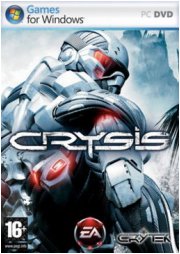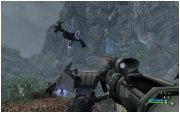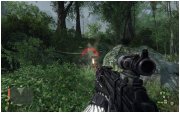Weeklies



Game: "Crysis"
System: PC
Genre: Action
Published by: Electronic Arts
Reviewer: Dr. Boogie
Posted: 2/18/2008
Review: When I first got Far Cry oh so many years ago, I thought it was a great game. First person shooters, for the most part, had been fairly linear in their approach, and yet here was a game that let you stalk through a tropical jungle, sniping mercenaries from the bush or just maneuvering around them. And it looked so good! Well, it didn't look as good because my computer wasn't quite up to snuff at that point, but it still looked pretty good. Imagine my excitement when it was announced that the followup game, Crysis, would build upon both gameplay and graphic elements from Far Cry.
You play a special forces agent codenamed "Nomad". You and the other four men in your team have been dispatched to an island in the Philippines to rescue a group of archaeologists who have run afoul of the North Korean Peoples Army. Fortunately for you, the game takes place in the far off year 2020, and your squad has been outfitted with the military's new "Nano Muscle Suit", giving you super strength, super speed, bullet protection, and a cloaking ability. It's just the sort of thing you need to take on an army of NK soldiers, as well as a few hostile aliens here and there.
Despite you're being in a squad of soldiers, most of the gameplay will involve Nomad making due all by himself. Luckily, his nanosuit makes him more or less a superhero. As mentioned, the suit has four different modes that you can switch to on the fly: maximum strength lets you punch harder and jump higher; maximum speed lets you jog slightly faster and lets you sprint about 50 mph for a few seconds; maximum armor lets you absorb a few rounds and boosts your health regeneration; and cloak lets you turn invisible for a period of time. Use of the four modes is tied to the suit energy, which recharges on its own and is consumed whenever a power is in used (I.e., when you're getting shot in maximum armor mode).
All four modes are useful, but for my money, cloak is the best. While moving, your energy drains quickly, and it drains completely if you shoot while cloaked. Even so, you can use it to set up quick ambushes, and then escape just as quickly once you're revealed yourself. Even if you prefer to march in with guns blazing, cloak is the way to go. Maximum armor will absorb 2-3 shots of gunfire, but when the enemy is using automatic weapons, that just won't cut it. Disappearing and then reappearing when you pop your opponent in the back of the head, on the other hand...
Also notable are the weapon attachments. Nearly every weapon you wind can have a few attachments... attached to it, running the gamut from a simple silencer, a laser pointer, a grenade launcher, and even a sniper scope or two that you find in the field. Best of all, you can apply these attachments as many times as you want, and you don't need to remove them when you ditch the weapon. You can even go so far as to apply a scope to your shotgun, though you aren't likely to see any results apart from a lot of confused North Koreans.
Taking the new gameplay dynamics that come with the nanosuit, the game still plays a lot like Far Cry, with little elements tweaked here and there. Most notably, your binoculars no longer instantly tag every single person in your field of vision, so no more climbing to the top of a hill, briefly aiming your binoculars at an enemy camp, and then heading in to pick them off one by one. You can still tag enemies, but you'll need to center your binoculars on each soldier and vehicle for a moment to mark them on your radar. Also gone from Far Cry is the adaptive difficulty, though you aren't as likely to miss it, as the enemy AI has been tweaked as well. If you barely miss a headshot on a guard, you can expect them to crouch suddenly and run for cover, calling for help or just lobbing a grenade your way, depending on the situation.
There's just one catch. It's the one catch that has be most reported on, and it's the one thing you'll notice soon after you start the game: in order to look good and run smoothly, Crysis requires you to have a beast of a PC. I recently upgraded my own PC with components that weren't available when the game was first released, and it still doesn't run at the recommended settings all the time. As for my old PC, forget it. On that machine, the game was theoretically good-looking. And frankly, how many gamers out there can afford to upgrade to a high-end machine every time a great new game with high hardware expectations comes out? Not that many, as it turns out.
It's only one problem, but it's a big one. When you're designing a game, it's important to consider what your audience wants, but it's equally important to consider what they can handle. If you're making a game that requires a goddamn supercomputer to run well, then all you're really doing is making a really elaborate benchmark for all those PC hardware reviewing websites to illustrate the power of the latest processor/GPU.
Overall rating: ![]()
![]()
![]()
![]()
(Scored on a 0.5 - 5 pickles rating: 0.5 being the worst and 5 being the best)
Reader Comments
Ok, that never happened.
As you can tell though, i'm the kind of person who likes to waste his hard earned money on frivolous crap, instead of the important things like rent and PCP. Don't be like me kids!
Honestly, though, I think I'll just get it on a console. I don't have the cash to pimp out my pc.
Follow us on:
![]()
![]()
![]()
![]()
Want Your Ad Here?
Send us an email!





